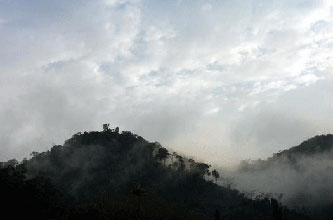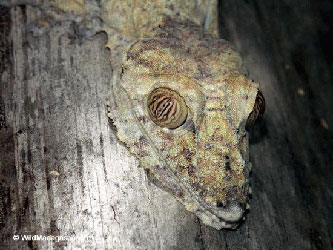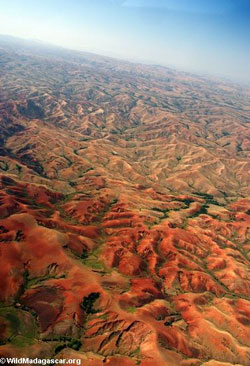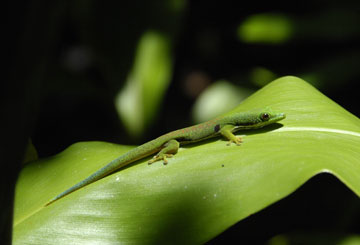An interview with lemur expert Dr. Patricia Wright
Conservation is saving lemurs and helping people in Madagascar:
An interview with lemur expert Dr. Patricia Wright
wildmadagascar.org
May 7, 2007
Madagascar, an island nation that lies off the coast of southeastern Africa, has long been famous for its unique and diverse species of wildlife, especially lemurs—primates found nowhere else on the planet. In recent years, the island country has also become world-renowned for conservation efforts that are succeeding in spite of extraordinary pressures from a poor population that relies heavily on forest burning for basic subsistence.
A large part of this success is due to the early efforts of Patricia Wright, a primatologist who has been working in the country for more than 20 years. Wright led the effort to launch the country’s leading protected area and helped Madagascar become a leading global example of conservation despite its economic adversity.
In what has become one of the best-known stories of species discovery in the latter half of the 20th century, Wright and her colleagues discovered a species of lemur, the golden bamboo lemur, in the montane rainforests of Ranomafana in 1985. Building a coalition of local community leaders, and with support from international donors, Wright was able to persuade the Malagasy (as the people of Madagascar are known) government to set aside more than 40,000 hectares as Ranomafana National Park. Today, Ranomafana is one of Madagascar’s best known and most important parks, serving as a model for subsequent parks and reserves in the country and abroad.
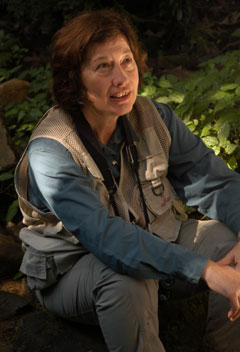
Dr. Patricia C. Wright in Ranomafana National Park |
Wright is still actively involved in research and conservation efforts in the park and other parts of Madagascar. Each year, through Earthwatch and Stony Brook University (New York), she leads teams of students and interested non-academics into the forest to learn about Madagascar’s ecology as well as what does and doesn’t work in conservation. Besides serving as a hub for research by both foreign and Malagasy scholars, Ranomafana has also generated substantial benefits for the local population, including more economic opportunities, improved health care, and better education for communities around the park. But despite the progress, Wright says, a lot more resources are required to bring the rest of Madagascar’s parks up Ranomafana’s level. Even within Ranomafana, continued funding is needed to support park infrastructure and staff.
More broadly, Wright is greatly encouraged by the enthusiasm of Madagascar’s current president, Marc Ravalomanana, for conservation efforts in the country. In 2003 at the World Parks Congress in Durban, South Africa, Ravalomanana shocked delegates by announcing plans to triple the size of Madagascar’s nature reserves by 2008. Shrewdly, he explained that “we can no longer afford to sit back and watch our forests go up in flames… This is not just Madagascar’s biodiversity, it is the world’s biodiversity.” Ravalomanana convinced donors that saving Madagascar’s wild places was going to require support from the international community—support which he since found. Today, Ravalomanana is something of a poster child for conservation efforts in Africa and also garners widespread popular support from the Malagasy people—absolutely key to conservation success, Wright says.
In January, 2007, Wright spoke with mongabay.com about her experiences in Madagascar and her thoughts on the future of conservation on the island.
Mongabay: I just heard a rumor that you might be building a canopy crane in Ranomafana. Is this correct?
Wright: We’re hoping to add a canopy walkway and possibly a canopy crane. It’s a project we’ve been working on for years, raising the money and making the operational arrangements. It’s been a challenge to plan how to build it without disturbing the forest but I believe it offers a lot of potential..
Mongabay: And this would be geared towards research or tourism?
Wright: We’re trying to work out something where would could have both. It would be primarily be used for research but the park would let tour operators use it on certain days for specific intervals We need to be careful that tourists don’t disrupt ongoing research in the park.
Mongabay: But overall tourism has been important in Ranomafana, right?
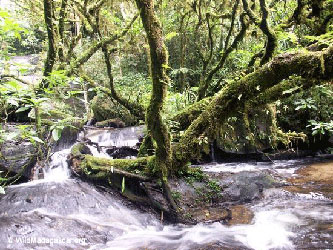
Ranomafana National Park. Photos by Rhett A. Butler |
Wright: Definitely yes. Initially I was skeptical that money from park entrance fees was actually going to make it back to the communities, but I tracked it and was surprised to see how well the system works. 50 percent of entrance fees really do go back to the community.
I think the success of the program has something to do with the egalitarian nature of the Malagasy — everyone wants to be sure the system is fair because everyone has a vested interest in the park. At the community level Madagascar is very democratic — everyone who wants a voice has one. The system works because it requires the members of the community to think about conservation issues. The system is also very open so participants can carefully watch the money, reducing the risk of corruption. People from other villages can see the success — espcially that no one is taking money off the top — and they want to become involved.
Mongabay: What about more direct involvement, in terms of locals hired as guides, research assistants, and park rangers?
Wright: We have 65 villagers working as research technicians. They do just research — no guiding. They have a regular year round salary, are paid for overtime, and get healthcare benefits. Then there are the tourist guides. They aren’t paid year around and don’t get healthcare benefits, but when they do work, they really make a lot of money. But it’s not year round. There may be close to 50 of them working in Ranomafana. During the high season they are all be busy, but as season winds down, only the good ones get the opportunity to be tourist guides.
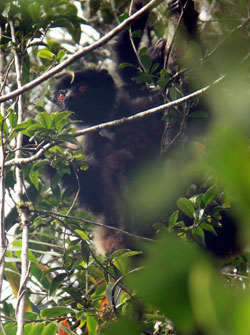
Milne-Edwards Sifaka at Ranomafana. Photo by Rhett A. Butler |
At first I was concerned that the tour guides were making more money than my research assistants, who are working solid 8-hour days five days a week. I did the math and I realized that if you average it out over the year, it’s more or less even. It’s just the tourist guides make a lot of money at one time of the year and not so much at other times.
Because of the egalitarian nature of Malagasy society there’s the feeling that everyone should be equal. So if someone’s making $3 a day while someone else is making $15 a day it’s going to create problems. Once they — the research assistants — understand that over the course of the year, they are making more money plus get health benefits and advancement opportunities, they are OK with it. The money itself is not the problem, it’s the “he makes more than i do but i work harder than him” mentality that’s the real issue.
Overall the park has had tremendous economic benefits for the surrounding communities. Ranomafana creates a lot of employment opportunities between research assistants, tourist guides, and park rangers.
Mongabay: Will Ranomafana ever be self-sustaining or will it always require some outside assistance?
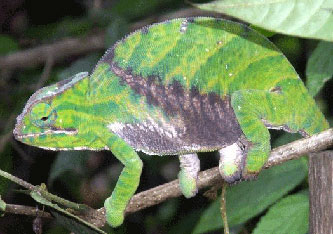
Parson’s chameleon in Ranomafana. Leaf-tailed gecko in Ranomafana. Photos by Rhett A. Butler |
Wright: Well I don’t think there is any national park that is sustainable in the world from an economic standpoint — even Yellowstone receives subsidies — but today I’m a lot more optimistic about how much money is needed to maintain basic operations. There is increased revenue and the money goes to the right places. If you don’t have corruption and people are coming to the park, then the park generates money to pay staff salaries and fund infrastructure, although currently the World Bank pays the salaries of people who work in the park, but not tourist guides or researchers. We pay the researchers through funds we raise from donors. This is one reason why need to continue to get funding. It bothers me when people say “Ranomafana is fine. It doesn’t need any money.” Yes, while it’s a lot better than it was 20 years ago, and it’s a lot better than it was ten years ago, by no means are all the problems solved. And then you step back and look at other parks in Madagascar. Now that’s a different story.
Of course, there are ancillary benefits that Ranomafana provides for people in surrounding areas. Hotels, restaurants, small stores — these all benefit from tourism. And it snowballs. because every time a new hotel opens it generates employment for everyone from maids to cooks to gardeners, A lot more people are getting salaries thanks to Ranomafana, The spin off is amazing to watch. Beyond salaries, locals get tips and extra things tourists leave behind. Each one of these employees has a family so the park is supporting a tremendous number of people.
I love looking at my old pictures from 1986 and 1987 because you can see the change. Back then people were so poor; today they are much better off. Sure, to someone coming from the United States they look poor, but it’s not the same as being so poor that they don’t have money to buy clothes, medicine or even enough food to support their families. Back then people were barely just scraping by and disease was a big problem. Things are so much better now, but of course Ranomafana is kind of a special case because researchers are habituating the animals, which makes it a better experience for tourists. Madagascar’s lemurs are more approachable than primates in other parts of the world due to their biology, but habituation is still helpful in allowing tourists to see these animals up-close.
Mongabay: It seems like there are other benefits to having researchers around insofar as disseminating information to visitors.

Deforestation near Ranomafana. Photos by Rhett A. Butler |
Wright: Yes, but that’s one of the things we really need to work on. We’re talking about a sort of visitor’s center at Ranomafana. People could come in to see things on rainy days and tourists who may not be physically capable of walking for hours on wet forest trails could still take something from their visit to Ranomafana. We’d have researchers giving lectures on some of the really interesting projects going on at Ranomafana — research that isn’t published anywhere. I think this is something that would really be of interest to the types of travelers who come to the park.
We’re currently building a 3 story structure next to the guard station. The top floor will be the visitor’s center. Visitors will be able to come in to see a lecture or movie that will make them aware of the exciting research going on here.
Mongabay: What about local outreach?
Wright: Certainly, though we do some of that already through Centre ValBio (Centre International de Formation pour la Valorisation de la Biodiversité). At Christmas we have about 4000 kids come in for a pageant. We give out prizes to kids who passed certain tests — the children love it.

Microcebus rufus mouse lemur in Ranomafana. Photo by Rhett A. Butler |
We also have a little microbus, we call it the “microcebus” (Microcebus the scientific name of the mouse lemur, the smallest type of lemur), to bring children in for nature walks and show them what the research station is all about. Using a grant from the Susan and Stephan Findel Child and Tree Fund — a foundation started by volunteers on one of my Earthwatch trips in 1999 — we are working with 9 schools to grow endemic plants in nurseries, learn about growing vegetables for nutritious lunches, and give them a chance to take a walk in the woods.
Mongabay: And the kids are enthusiastic about this?
Wright: Definitely. We did a survey and found that about half the students said they wanted to be tourist guides or research assistants. So they are really getting into that. Without those kids we’re doomed — but if we can really get them interested in that forest, then there’s hope. They are the future.
Mongabay: More broadly, what’s your outlook for Madagascar?
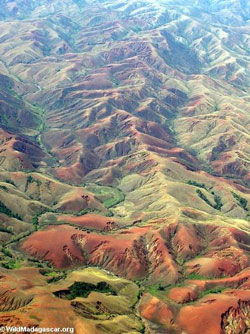
Deforestation in Madagascar. Photo by Rhett A. Butler |
Wright: Well if it wasn’t for President Ravalomanana, I would be more pessimistic. He ran on an environmental platform and got overwhelming support in this last election. It was quite a statement when he said was going to triple protected areas within six years. Some people were skeptical of the President being able to accomplish this much on such a short timeline, yet he has already done a third of this and he should be half done this year — quite an achievement. He’s been an incredible impetus for conservation efforts in the country.
Having leadership at the top is really important. For example, Ravalomanana is really trying to get rid of corruption, which is a big problem in Africa. Corruption makes it extremely difficult to get things accomplished. Ravalomanana is also appointing qualified people to top positions. For example, Koto Bernard, who used to work for WWF and has spent time in the US and Europe, was just named minister of the environment. This is terrific news for Madagascar, Koto is smart and dynamic and has really been an active player in environmental outreach for Madagascar. I’m very excited about him in the role.
When you have the will at the top it does trickle down. If we want to take on a national conservation initiative, we really need an education campaign with television spots, radio advertisements, and posters. We need more funding for protection in parks that don’t have tourists. For some of these protected areas there is virtually no park staff presence. This means that local people cut and burn forest — not necessarily out of spite or defiance but simply because that’s the way they’ve always lived and there’s no one there to tell them otherwise. We need a physical presence in these remote parks and clearly marked borders. We’ve got really fantastic people working for the departments of water and forests as well as ANGAP (Madagascar’s national parks agency which has recently been renamed to SAPM), but we simply do not have enough people on the ground. We need more funds for staff in remote areas and vehicles. I’m worried about the whole national program because we now have donors saying they don’t need to give more money to Madagascar. We need more money! It’s worth it because Madagascar is such a special place.
My pessimism, if I have any, is population growth. You can’t keep increasing population without running into serious environmental problems. We’re working to address this. Cornell is working with the System of Rice Intensification (SRI) to improve rice cultivation around Ranomafana which has had a big impact on yields and community well-being in the area. It also helps reduce pressure on forests.
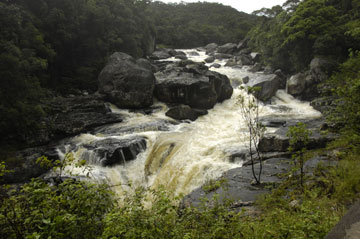
Ranomafana river in Ranomafana National Park. Photo ©Julie Larsen Maher Phelsuma Day Gecko in Ranomafana. Photo ©Julie Larsen Maher |
Another positive is it looks like we can reforest some of the terribly deforested areas. One of my pet projects is to restore some of this devastated land which may cover something like 80 percent of Madagascar. As you know, we have burning in Madagascar. Unlike places like South America where rainforest might come back a few years after logging or cutting, in Madagascar this rarely happens because the Malagasy burn so much. They cut the forest and then burn it again and again. It’s a cultural thing — they’ve been doing this for more than 1000 years, but with the poor soils and greatly diminished extent of forests, it simply can’t be done anymore. We need the president to say that burning is a bad thing and make it illegal. When the burning season starts, everyone who does it should be briefly arrested to get the point across. Where he’s done this it has worked — they don’t burn any more. Once we stop the burning we can focus on reforestation.
I have to tell you a story because it amazes me still. In 1988 when we started Ranomafana national park we brought in an agricultural expert, Daniel Turk, who was a graduate student at North Carolina state working on his dissertation. To measure growth rates of native trees, he started a nursery of endemic species. When he was finished with his dissertation, he took the seedlings and planted them outside the nursery but he didn’t ask me where to plant them. I was away at the time, but when I returned and saw where he had placed them, I was horrified because he planted them in this awful deforested wasteland — it was like he was throwing the seedlings away. These were rainforest plants that typically grew in the shade of the canopy to eventually become 35 meters tall.
Well last year someone told me that I needed to take another look at the trees. To my astonishment, after 17 years those trees were not only alive, they were thriving: 20 meters tall, flowing and fruiting! I couldn’t believe it! And the difference of growth rate of growth was encouraging. We know how fast the trees grow inside the rainforest but these trees were growing faster outside the rainforest. So yes, this means there’s hope. Now we know that trees can grow on deforested land — as long as they aren’t burned — and that they grow fast. You might have a rainforest in 50-100 years, complete with an understory and a canopy. Lemurs and birds can return and you have a healthy forest again. It was a real surprise for me and shows that there are glimmers of hope if you can stop the burning.
Mongabay: Wow, that’s really an uplifting story, especially given the soil conditions in deforested areas of Madagascar. What about the impact of climate change? In 2005 you and colleagues published a paper in the Proceedings of the National Academy of Sciences that correlated changes in rainfall to lower reproductive success in Milne-Edward’s sifakas — how will climate change affect lemurs and, more generally, Madagascar?
Wright: First of all look at how far south Madagascar is — areas closer to the poles are going to be most affected by climate change. Also we need to consider all the devastation — the forests are more than 80 percent gone — making ecosystems there all the more susceptible to change. The big impact could be from changes in rainfall — not less rainfall, but altered distribution of rainfall throughout the year. Less than average rainfall during some months and more at other times. For the lemurs, older females aren’t able to nurse babies when there’s too little rain during the times of year when they are nursing. A slight change in climate, even in the rainforest, can impact survival for baby lemurs.
Mongabay: Changing gears a bit, do you have advice for students who want to pursue a career in conservation in Madagascar?
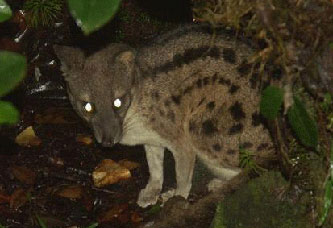
Striped Civet in Ranomafana. Photo by Rhett A. Butler |
Wright: I always tell students “come to Ranomafana first.” The truth is, I think I’m the only one who actually accepts students. WWF doesn’t take interns, nor does WCS (the Bronx Zoo-based Wildlife Conservation Society). My organization is university-based so we are used to teaching students and doing capacity-building, both for Malagasy students and students in the developed world. For kids from places like the States, seeing a place like Ranomafana can be very inspiring, otherwise they might just end up working for a bank in Manhattan, never knowing what they are missing. So I’m very open for people coming to work on conservation in Madagascar. It depends what their skills and interests are but, but students from many disciplines can help. For example we have health and education teams going around to villages doing surveys as well as budding biologists tracking lemurs through the forest. We have students looking at plants, mammals, frogs, water, and even village economics. There’s lots of work at Ranomafana. In the Fall I bring a study abroad group from Stony Brook University. These are undergrads that work on professor’s projects. I even get people who already work for conservation organizations coming out here to try something new.
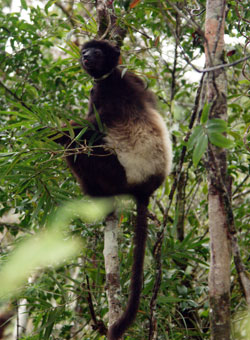
A Milne-Edwards Sifaka that has been tagged for research at Ranomafana. Photo by Rhett A. Butler |
So I’d say, first of all, write to me. Second, go online to the National Geographic Society web site. They just opened up a new pot of money for students — it’s called the Young Explorers Grants program. The program is for 18-25 year olds who are interested in becoming researchers, explorers, and conservationists. It’s perfect for kids who are in college or in a gap year after college.
With these types of field-based experiences, a person is much more appealing as a prospective employee to a conservation organization. It also can help a student get into graduate school programs. There are particularly good programs for conservation at Yale, Duke, and Columbia. Stony Brook University is in the process of building a very future focused program in Environmental Issues and Conservation.
There are lots of jobs available in conservation to people from all different backgrounds but you usually need to get a degree to get through the door. People need know that you are not dewy-eyed and that you understand what conservation is really like on the ground.
Mongabay: How can people abroad help conservation efforts in Madagascar?
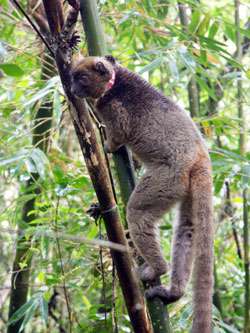
A Greater Bamboo Lemur that has been tagged for research at Ranomafana. Photo by Rhett A. Butler |
Wright: Of course I’d say raising money for projects is always a good thing. People can go on the Institute for the Conservation of Tropical Environments (ICTE) web site and see what we have going. School groups are a wonderful way to collect educational materials — pencils, books, and things like that, since school supplies are often scarce in Madagascar. Classrooms can also collect money to send to schools in Madagascar. There are non-monetary things as well. For example I’m trying to set up a video system that would allow students in places like the United States to see students in villages around Ranomafana. They system would also allow local kids to see what sorts of science we’re doing in the park. Pen pal relationships are fun for kids.
Mongabay: Aren’t there language barriers?
Wright: Yes, but we do a lot of drawing exchanges. When do videoconferencing we have translators
If people really want to help on the ground they can sign up for an Earthwatch trip. Earthwatch one of my favorite things because the people who come want to see what’s going on in Madagascar and most of all, they want to help. The program is great for our staff. It keeps my research assistants set with salaries, which is really important when you’re doing a long-term project. I don’t know if you realize this but doing a long-term project can be difficult to fund. Mine has been running over 20 years. You constantly need to be writing new grant proposals just to keep to money flowing. You might even have a couple of years with no funding — times when you are scrambling to figure out how to pay your research assistants. It’s very difficult to get long-term funding from granting agencies, so Earthwatch is my solution to that. Plus I get to meet people and talk with them about how they can help further. Sometimes ancillary projects develop — for example, the Susan and Stephan Findel Child and Tree Fund education outreach program I mentioned before. That was started by an Earthwatcher who came to Ranomafana and then developed her own project. She comes every year to make sure her project is being done right. It’s been fantastic.
Earlier Madagascar Interviews
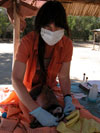
|
Michelle Sauther, lemur expert at the University of Colorado-Boulder Feral beasts threaten lemurs in Madagascar — 02/07/2007 Dr. Michelle Sauther, an anthropologist at the University of Colorado at Boulder, is currently developing a project to assess the threat to lemurs from introduced species such as the Indian civet and mongoose, but especially dogs and cats that have become feral. Specifically she plans to examine the impact of introduced mammals on the iconic ring-tailed lemurs and Verreaux’s sifaka at the Beza Mahafaly Special Reserve in Madagascar. |
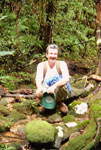
|
Charlie Welch, lemur expert at the Duke University Lemur Center Lemur conservation in Madagascar requires poverty alleviation initiatives — 11/05/2006 Madagascar, an island larger than France that lies off the southeastern coast of Africa, is perhaps best known for its lemurs–primates that look something like a cat crossed with a squirrel and a dog. Lemurs, which are found naturally only in Madagascar, serve as a charismatic representation of the island’s biodiversity and its problems. The good news is that because of Madagascar’s biodiversity, the island has become a top priority for global conservation. At the forefront of these efforts is the Madagascar Fauna Group (MFG), an international consortium of zoos and related organizations that work to protect Madagascar’s wildlife and ecosystems, and the Duke University Lemur Center, the one of the world’s leading lemur research facilities. Charlie Welch, currently a research scientist at the Duke University Lemur Center, recently answered some questions on his experiences in lemur conservation. |
